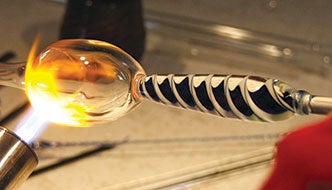Concerned about the scarcity of industrially relevant glass research in academia, Corning has launched a program to help build a strong future for the U.S. glass industry. The company took a major step toward that goal in August as two professors from Rensselaer began work at Sullivan Park Research and Development facility in Erwin, N.Y., as part of the newly established Gorden S. Fulcher research program.

Yunfeng Shi and Liping Huang
The inaugural distinguished researchers of the Fulcher program are Liping Huang, associate professor of materials science and engineering, and Yunfeng Shi, associate professor of materials science and engineering. Huang did her postdoctoral work at the University of Michigan and North Carolina State University before joining the faculty at Rensselaer in 2008. She won the Norbert J. Kreidl Award, the highest honor bestowed upon a student by the Glass and Optical Materials Division of the American Ceramic Society, in 2003. Shi’s research focuses on simulation and modeling of advanced materials systems. His recent interests include nanoporous carbon, molecular motors and energetic materials. Shi received the Best Poster Award from the Materials Research Society in 2002 and the Albert Yee Award from the University of Michigan in 2005.
The Fulcher program’s objective is to enable close engagement between university professors and Corning scientists on research topics of mutual interest—especially those related to the fundamental science of glasses that are most likely to be used in a commercial or industrial setting. A new Fulcher awardee will be selected each year.
“We feel that the direct linkage this program provides will put key members of academia in the front lines of glass research so they have the best sense of the direction to steer their research and how best to prepare their students,” said Dan Vaughn, manager of external technology collaborations and intellectual assets at Corning.
While Corning’s R&D facility has hosted professors on sabbaticals before, this is the first time the company has designed a focused program and invited members across academia to apply for it. The program is a direct result of work Corning has taken on over the last few years to engage funding agencies and industry leaders in a conversation about the future of glass research and how best to ensure the glass industry has a thriving pipeline of well-qualified scientists and engineers for years to come. It is also one of the first glass research programs in the U.S.

The program’s namesake, Gordon Scott Fulcher, was a glass and ceramic scientist best known for the creation of the three-parameter model of viscosity known as the “Fulcher equation.” Glassforming is done at about the working point, which is defined in terms of viscosity.
“We actually began this journey two years ago when we were having a difficult time finding the right candidates for open positions within Glass Research,” said John Mauro, senior research manager of Glass Research at Corning. “So we teamed up with the external collaborations group to investigate the issue a little further.” One of the big findings the team uncovered was that the amount of research at universities in key areas relevant to Corning and other major U.S. glass manufacturers was substantially less than expected.
The team published a paper titled “Glass Science in the United States: Current Status and Future Directions” in early 2014 and also hosted a Glass Summit in Corning, N.Y., a few months later in hopes of stimulating conversation in the glass research community on the future direction of glass science.
“The summit was a huge success—with more than 120 participants from Corning, academia, and various funding agencies from around the globe,” said Dan Vaughn, manager of external technology collaborations and intellectual assets at Corning. “It generated many great ideas, including the development of the newly established Gorden S. Fulcher program.”
The program’s namesake, Gordon Scott Fulcher, was a Corning glass and ceramic scientist from 1920 until 1934 who is best known for the creation of the transformative three-parameter model of viscosity known as the “Fulcher equation.”


